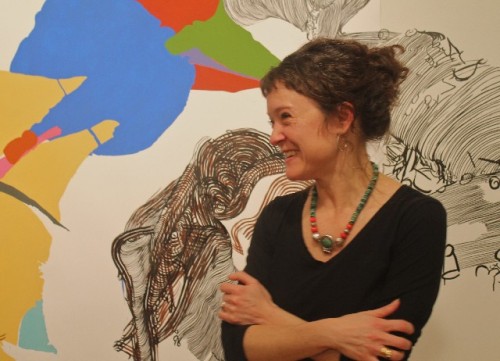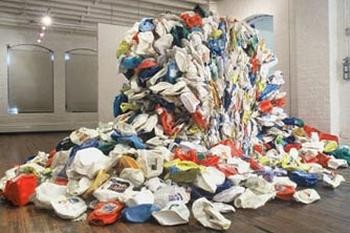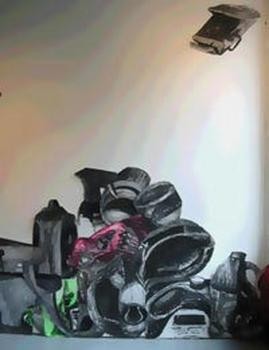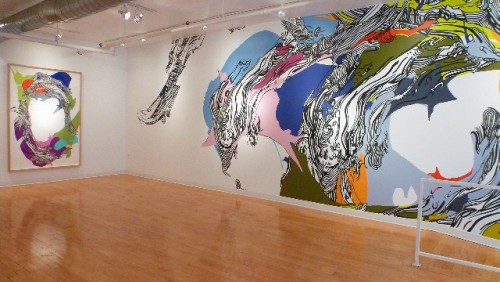Trash Talk with Sophia Ainslie
Installations from Recycled Materials
By: Charles Giuliano - Sep 24, 2013
Typically, installations such at the one on view currently at the Essex Art Center in Lawrence, Massachusetts, by the South African born, Boston based artist, Sophia Ainslie, involve industrial strength bricks of compressed, recycled, colorful, plastic detergent and bleach bottles. Depending upon the space allotted them, and the patience of the curators involved, this may range from a modest cube to a daunting blight of urban sprawl. All in the good name of art.
In January of 2004, I co curated, with Arthur Birkland, an exhibition “Stitches: A Fiber Arts Collaboration” in two locations, New England School of Art & Design, as well as Newbury College in Brookline, Mass. The idea to do a fiber themed show was Birkland’s but I suggested stretching the definition of the medium.
Ultimately that involved Sophie parking a bale of plastic waste outside the library/gallery building of Newbury College in the upscale neighborhood known as Fisher Hill. It was quite a provocative stunt that entailed first selling the idea to the president of the college who then required the permission of the neighborhood association. Since we were working with minimal funding the artist needed to get a waste disposal outfit to deliver and later pick up the bale.
After some initial research Sophie not only convinced Michael Crowell, the operations manager of FCR in Charlestown, of the legitimacy of her request, he has subsequently been a friend and collaborator for several projects. The first sculpture with recycled waste material was created during time as a resident at Skowhegan School of Art in Maine. It was a portfolio of images from that early work that inspired me to include her in the well received “Stitches” show. It was a real coup and a lively conversation piece that served to draw passers by to wonder what was up at the college. Just what was the pile of junk doing in front of the library? And, of course, was that really art?
Well friends, it is if Sophie says it is. And, trust me, she can be very persuasive. We chuckled recalling that project as we met to discuss her work and early years in South Africa. A feminist, concerned that the Beer and Burger series has focused on guys, suggested that I expand the concept to include “Salad and Chardonnay With…” But Sophie, a wee bit of a woman, with a mop of curly hair and a warm infectious humor, was more than glad to cozy up to a couple of pints of Guinness and split an order of wings.
We had talked on a number of past occasions, including a visit to her exhibition at Hall Space a while back, so I knew a lot of the fascinating background, but this time I scribbled notes.
Her father, an artist, Bill Ainslie, founded the Johannesburg Art Foundation, in the 1960s which was closed in 2003. Although it was illegal under apartheid the school had black and white students. “We weren’t allowed to communicate across race lines,” she said. “It was ok to employ blacks for labor but not to have them for friends. It started small but quickly grew and developed into a school for 500 students. It worked on the barter system and my mother fund raised. There was money from the embassies including the Dutch and Swedes. We were always under surveillance. There was a car parked outside but somehow my parents never got busted. At first the students walked to the school which was some distance but eventually they began to stay in our house. There were raids and our phone was tapped. Eventually there were warnings and when I was a baby my parents left South Africa for three years.”
They came back and continued the school. “My father died in 1989 in an automobile accident,” she said. There were several injured in the car but he was the only one who died. At the time he was 55 and Sophie was 21. I asked if there was foul play? She replied that there has never been a clear answer to that question. For a time her mother continued to run the school.
From such a strong artistic and educational background she was destined to follow in their footsteps but not without adventure and rebellion. “I have been in and out of school all my life,” she said. “After high school I needed outside input. I earned a BFA at the University of South Africa where I majored in drawing. As a teenager I partied every night. There was a bar called Jameson’s which was biracial. You just did it. People just did things. Stuck your neck out. We drank and smoked and talked about art. I was doing large black and white drawings. I was always the first person in the bar and the last one to leave at 5 am. My father said that was ok but I had to be up at 8 am and in the studio by 9 where I worked until 8 pm. Then I was ready to go out again. I would bring a sketch book and draw people. The next day I would enlarge the sketches. It was a lively time.”
She started to attract attention and had her first one person show at Goodman Gallery and won awards while still in her 20s. She sold well and got reviewed as well as interviewed on TV. But there was a change in the work. As she explored color the figures started to disintegrate. By 1996 she was invited for a seven week residency and exhibition at Gasworks Studios in London. The show sold out. This was followed by a year as a resident in San Francisco and on to Boston in 1998 to pursue an MFA at the School of the Museum of Fine Arts (2001) where she now teaches. There she was influenced by Ondine Chavoye who taught courses in theory and post modernism. It expanded her possibilities. She stopped painting and began thinking about identity and displacement.
“Who am I,” she asked. “I am from a family of artists but who am I? I am an artist from South Africa. It seems the same on the surface but also so different. My brother and father were abstract painters. And I was painting but was I true to me? It (The Museum School) shook me up and I started over. There was a new humor and a new culture. People here watch and talk about TV. I had to become assimilated.”
How did that lead to making trash sculptures, large panoramic drawings of trash, and more recently digital prints of details of the trash? “Because there was an abundance of waste in America,” she explained. “I began new works and wanted to get off the wall. To get away from paint and canvas and brushes. In South Africa everything is recycled. Houses are made out of found materials. If the TV breaks you fix it. My family has the same TV from the 1970s. In SA you have your shoes repaired. Recycling is a business. Everything is a collage. For me the color is in the detergent bottles. In the glass and plastic. You can’t get rid of it. And the materials have their own identity and history. My work opens it up to a bigger audience and everyone can relate to it.”
She also talks about how to get her hand into the work through drawing. “The installations take space,” she said, “So what to do in the studio? I started drawing in a repetitive manner.”
And she keeps an eye out for new materials. She is an associate in art at the venerable Saint Botolph Club. She is curating a group show there this summer and will participate in a show in September. For that piece she asked the club dining room to save wine bottles. She plans to use them as a sculpture but hasn’t decided just how. “Do you have any ideas,” she asked.
I'll have to think about that.





